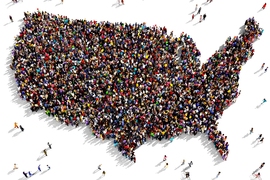Republican presidential candidate Donald Trump announced at last night's debate that he is open to challenging the legitimacy of this year's election — but MIT political scientist Charles Stewart III, a renowned expert on the U.S. election system, says no one should worry that the system is rigged.
“What is lost in almost all debates on this is that elections happen one precinct at a time,” says Stewart, a founding member of the influential Caltech/MIT Voting Technology Project (VTP), which was started in 2000 to prevent a recurrence of the problems that threatened that year's U.S. presidential election. “I don't think you can hack the election. ”
Why is that the case? Among other things, election observers are stationed in every polling place; ballots are counted in public; and post-election audits are conducted to spot-check results. Plus, the machines that record and count ballots aren't connected to the internet. As a result, Stewart says, Americans can be confident that their votes will be counted this November.
“In the last decade and a half, there has been a lot of progress in how America votes. The Voting Technology Project has been an important factor in defining what the problems are and aren't and providing scientific information about the state of elections and voting — for the passing of new election laws and appropriations,” Stewart explains.
To wit, early VTP research found that in 2000, an estimated 1.5 million to 2 million votes were lost because of voting equipment and ballot problems; 1.5 million to 3 million were lost due to problems with voter registration; and at least 1 million due to problems in polling places. This research helped spur the 2002 passage of the Help America Vote Act (HAVA), which made a number of improvements to the system, such as requiring states to allow provisional balloting — enabling voters who appear ineligible for some reason to cast ballots that can be verified later.
Those improvements have had demonstrable results. “As a result of changes to election administration and the replacement of old voting machines,” Stewart says, “roughly 1.7 million more votes were counted in presidential elections starting in 2004. An additional 1.4 million votes were recovered because of improvements in voter registration. As a consequence, in 2016, 3 million more Americans will have their votes counted than if the voting improvements fostered by HAVA had never happened.”
Improving elections by improving voting experience
This Election Day, roughly 800 students from more than 25 universities, including MIT, will be collecting data at polling places across the country to further ongoing election research organized by Stewart, who is MIT’s Kenan Sahin Distinguished Professor of Political Science.
Stewart has been researching lines at polling places since 2012 when an estimated 750,000 potential voters across the country left the polls without voting because of unusually long lines. "There is a bit of a mystery about why there are long lines in some locations," says Stewart. "What's the mechanism? Is it that the ballots are longer? Is it hard to get around the polling place? No one knows."
To investigate, Stewart is sending students out to gather data on wait times, line lengths, and polling place layout to assess whether queuing theory — the study of how lines form — can be applied to better manage elections. "This is how McDonald's decides how many cash registers it needs. You see this kind of data used every day, yet there is a sense that voting is just different from anything else," Stewart says.
Under Stewart's direction, teams of 10 or more students will be recording data in Boston; Fairfax County, Virginia; Richmond, Virginia; Orange County, Florida; and Bernalillo County, New Mexico. These sites were evaluated during the 2014 midterm election, and Stewart is interested in evaluating what, if anything, has changed. "We want to see the difference between a midterm versus a presidential election," he says.
Elsewhere, other university professors will be sending students out to gather data using the same protocols. Once the election is over, Stewart will collect and analyze all the data to try to answer the fundamental question: Why do lines form at polling places?
"Lines are the canary in the coal mine. If there are long lines, something is going on," Stewart says. "We want to know where the problems are."
Catalyzing engagement and civic pride
Stewart's current research is part of a larger endeavor, The Polling Place of the Future project (PPF). Developed by the VTP and supported by a grant from the Democracy Fund, the project focuses on applying the principles of queuing theory to the problem of managing voter turnout.
Stewart emphasizes that the nationwide effort to gather data this Election Day is not just about research, however. The project is also designed to get students excited about the election process. "Rather than studying elections from a policy perspective, this is getting in the trenches and trying to understand the world from the perspective of local poll workers or election officials," he says. "It's a way of combining social science research with engagement in these communities … [and] students love doing it. It's really energizing."
Nationwide, a million people will work the polls this Election Day in a wide variety of locations, from school gymnasiums to church halls, making it "a one-day expression of optimism and civic pride," Stewart says. "You get a heartening sense of the function of the process because of the goodwill and attentiveness of the people running the process."
Stewart is also hoping that lines will be shorter in some places this year thanks to work already accomplished by Polling Place of the Future. At the behest of the bipartisan Presidential Commission on Election Administration, PPF has developed a set of web-based tools to help officials run elections more efficiently. The tools are available online now to help election officials with such tasks as estimating wait times and determining how many check-in stations to provide to minimize lines.
Providing such practical, hands-on help is typical of the work MIT does in this as in other arenas, Stewart says. "Our unique voice is scientific, being impartial, trying to be helpful," he says. "I don't want to affect the outcome. I want to improve elections."













